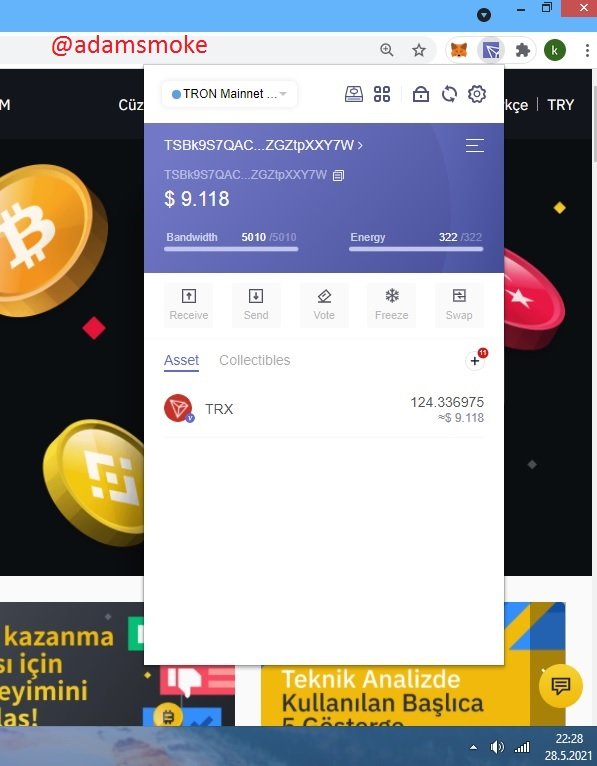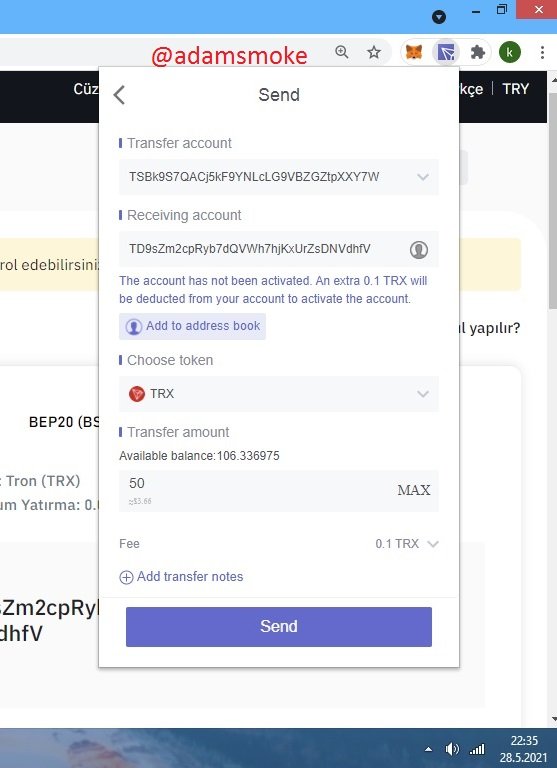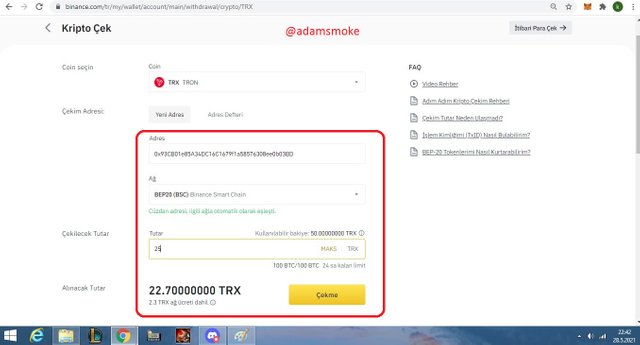Steemit Crypto Academy Season 2, Week 7 / Homework Post For @alphafx : Scalability and Improvements Made and Still to be made

Hello to everyone
First of all, I wish everyone who read my homework a good and healthy day.
Also, thank you professor @alphafx for this nice and instructive assignment.

Make a transaction on the Binance smart Chain and Tron blockchain (you can use any token)
I transferred TRX in both of my transactions because it is both economical and we can see the differences more clearly when transacting on the Binance smart chain and the Tron blockchain.
Tron blockchain Transfer
First, we need a cold wallet to be able to transact on the Tron blockchain. I will use my Tronlink wallet which was previously attached to my extensions. I transfer 50 TRX from my TronLink wallet to the binance exchange. I am sharing the steps with screenshots in order.




As seen in the screenshots, 50 TRX was sent to my Binance account.
Binance Smart Chain Transfer
Secondly, to use the Binance smart Chain, I send 25 TRX from the binance exchange to my Binance Smart Chain wallet.
If you don't have a Binance Smart Chain Wallet, you can easily add it from Google extensions. Then you can open your account easily with short and easy steps.
Then respectively:
To send TRX to the Binance Smart Chain wallet, we copy the address of our account.

Then, on the screen that opens, we write our Binance Smart Chain address and the TRX amount we will send. Our transaction is carried out for a transaction fee of 2.3 TRX.

22.7 TRX is coming to our Binance Smart Chain account.


Show the time taken for each transaction to be verified (original screenshots must be included)
Now let's examine the time it takes for these processes to take place.
Tron Blockchain Transfer

I completed my transaction at 22:36 according to Turkey time.
I'm reviewing my transaction on Tronscan.

As can be seen in the picture, it is seen that my transaction was approved at 22:36:09 Turkish time.
We know that transaction times on the Tron network are already very short. This process seems to have taken a maximum of 9 seconds.
Binance Smart Chain Transfer
Our transfer time on Binance Smart Chain appears to be 22:43 Turkish time. Confirmation of the transaction appears on the screen as 22:46.

Let's examine our transaction on Bscscan.com to take a closer look at the transaction.

Here we can clearly see the time when our transaction took place. The time that appears as UTC 07:44:36 PM becomes 22:44:36 Turkey time. So our process took about 1 minute.

Compare the scalability and speed of the two against BTC
Thanks to the transactions we made in our Binance Smart Chain and Tron blockchain homework, we can understand that it is much better than BTC.
The reason for this is that bitcoin uses Proof of Work (PoW). One of the downsides is that PoW's working logic is based on proof of work. Another downside is that the confirmation times of transactions are very long. Process times, which are completed between 8-10 minutes on average, are very high. However, in PoW, the more powerful your processor is, the more mining rewards you will earn. The biggest disadvantage of this is seen as the centralization of a decentralized system in the future.
However, Binance Smart Chain uses Proof of Stakeed Authority (PoSA). On the Tron blockchain, it uses Delegated Proof of Stake (DPos) algorithms. These algorithms work with almost the same logic.
Compared to BTC, as we said before, they have very fast transaction confirmation times. Block creation times are 3 seconds for both. We could not fully see this in our transactions, but when we examine it over Tronscan, we can see that it is a value close to this value. Another feature of these two systems is that they have super witnesses. There are 21 super witnesses in the BSC and 27 in Tron. In addition to these features, if we come to scaling comparisons, we will see that there are big differences between them.
BTC scalability is 7 transactions per second while Tron and BSC have 2000 transactions per second. Scalability is one of BTC's biggest gripes. Although they try to solve this problem most of the time, it is still not a solved problem. I think it will remain a problem in the future.

What do you think can be done to improve the scalability of these three (BTC, Tron, Binance Smart Chain)
As we said before, Bitcoin uses the PoW algorithm. We can say that the PoW algorithm is the main reason for the emergence of many problems. Because it uses PoW, the processing times are very high. The prolongation of these transaction times also reduces the transaction confirmation speed considerably. Many blockchains work with PoS algorithm such as BSC, Tron. This increases the processing speed. However, it is known that the speed of central systems such as Visa can reach up to 4000 TPS. When compared to Bitcoin, we can see that there are gaps between them.
BTC tried to increase its scalability by increasing the block size in 2013. However, this remained as a temporary solution. Because this would cause a huge increase in the block size of BTC and monopolize the mining of BTC and end decentralization.
To address these scalability issues, methods such as the Lightning network for Bitcoin have been developed. Lightning is one of the methods called off-chain transaction. These methods perform a transaction between users outside of the blockchain and are added to the blockchain when the transaction is finished. This could be one of the solutions.

Conclusion
In this lesson, we discussed what is scalability and what could be the solutions.
We tried to understand whether there is a difference between the BSC network and the Tron network.
We realized that scalability is a problem not only for today but also for the future.
It was again a very instructive lesson. Through this lesson, we tried to understand what the problems with blockchains are.
Thanks again to professor @alphafx for this nice lecture.
CC: @alphafx
I would have loved more elaboration on solutions but well done.
Thanks for participating